On October 16, the crew of a Lufthansa A350 inbound to San Francisco found themselves in an unenviable situation: a seemingly unnecessary last-minute diversion to Oakland after a long-haul flight. The diversion was forced by ATC, following the crews inability to accept a visual approach. The incident highlights issues with visual approaches in the US, particularly during late-night arrivals.
LH458 – What happened?
Here’s how it went down:
ATC: Expect a visual approach.
CREW: We can’t do visual approaches at night-time due to company procedures.
ATC: In that case, expect delays.
At this point in the story, instead of a visual approach on runway 28R, the crew were told to expect an ILS approach on runway 28L. They were then put into a hold – perfectly understandable for their integration into the approach sequence. After holding for 20 minutes, ATC advised there would be another 10-minute delay. 10 minutes go by.
4 minutes later:
CREW: If we can’t land soon, we’ll have to declare a fuel emergency.
ATC: What’s your diversion airport?
CREW: Oakland.
ATC: You need vectors to Oakland?
CREW: Er, no. What’s the problem here?
ATC: I can’t have this conversation with you. Either divert to Oakland, or you can continue to hold, it’s up to you.
CREW: Okay, you promised me 10 minutes, that ran out four minutes ago. So how many more minutes?
ATC: Conversation is over. You want to divert? Or you want to continue with the delay?
CREW: We’re diverting to Oakland.
This resulted in a flight time of over 12 hours, landing in Oakland an hour after commencing the approach to KSFO (and at 7 am Munich local time – the crew’s local time). After one hour of turnaround, the crew resumed their flight to KSFO, which took another 45-minutes block to block.
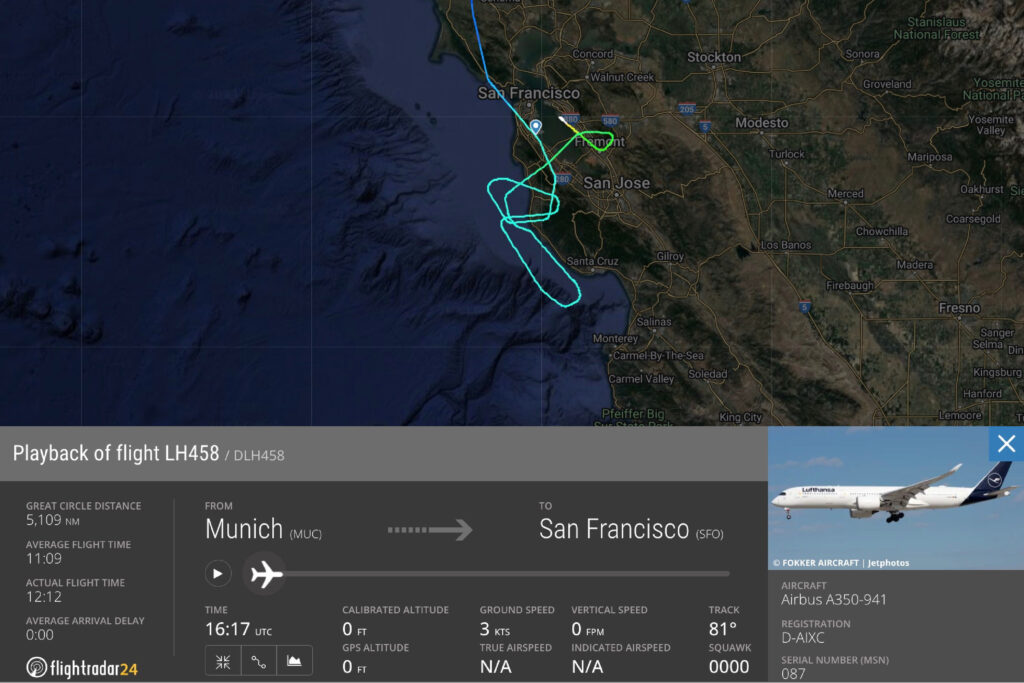
The first flight: Munich – San Francisco (diverted to Oakland)
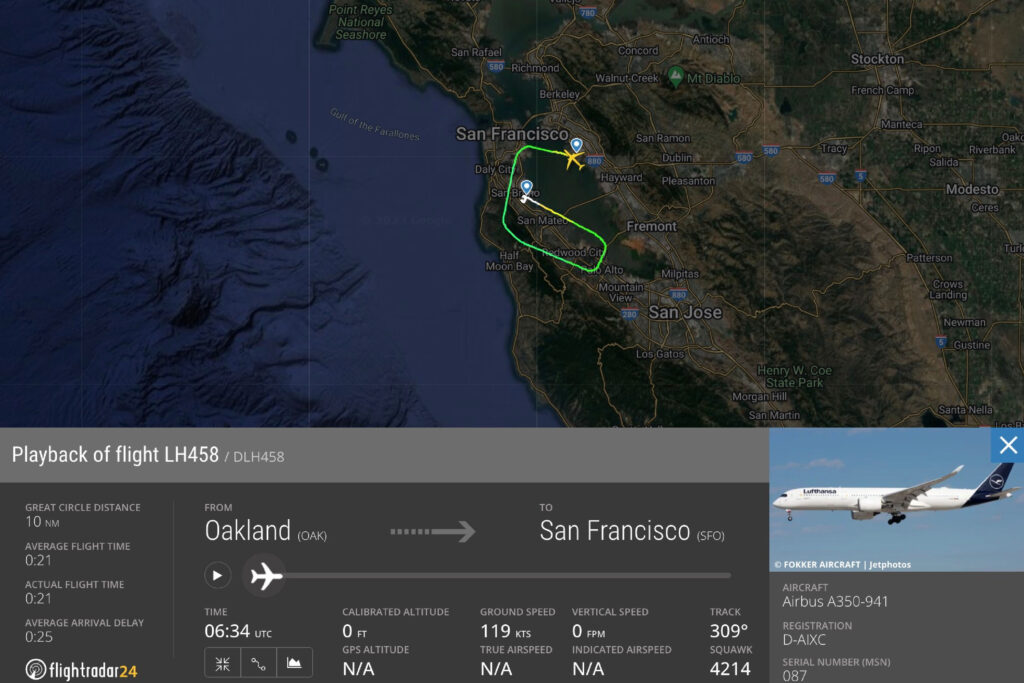
The second flight: Oakland – San Francisco
The delays are crucial to this story. It’s not uncommon for delays to occur, but ATC announcing a 10-minute delay (which is essentially treated as an EAT or Expected Approach Time), and then not adhering to it (especially after 30 minutes of holding) is not great. This significantly alters the situation and could have had more severe consequences.
A video of the flight path, including part of the audio between the crew and ATC is here:
What’s the problem?
In terms of flight safety, one can question the wisdom of subjecting the crew to signficiant extra fatigue after a long flight. Was it really not possible to create an additional two or three nautical miles of spacing between two aircraft for over 30 minutes to accommodate this flight?
Long Haul operations entail heightened risks due to extended duties and activities during circadian lows. While instrumental in facilitating aviation, the prevailing attitude within the US ATC tends to prioritize maximizing movements without seemingly adequate consideration for the nature of specific operations. It’s essential to recognize that not all arrivals are equal; when a pilot communicates inability, it’s not mere difficulty but a conscientious acknowledgment of the immense responsibility for the safety of hundreds on their shoulders. After a lengthy night of flying, we would all find it challenging to justify opting for a visual approach as the safer choice.
The FAA prohibits visual separation on an ILS. Consequently, questions arise about the request made to the crew in this regard, as well as the system that forces night-time visual approaches on all aircraft, regardless of the fatigue level of the crews and their unique circumstances.
This is a systemic issue. But it does feel like there is room to hope for a more comprehensive systemic approach to avoid putting a crew in a potentially safety-compromising situation.
Why was there a delay in the flight’s approach?
While a delay in air traffic is understandable, adhering to the announced duration (which clearly had the characteristics of an Expected Approach Time) is crucial to ensure safety. In this case, the crew experienced confusion when their EAT was not met, leading to concerns about fuel reserves and potential emergencies. Efficient coordination between ATC and crews is essential to prevent such situations.
Could the flight have been accommodated within the initially announced timeframe?
Considering that the flight had already spent over 30 minutes holding, it seems reasonable to think that they could have been inserted and provided with a few nautical miles in a thirty-minute sequence.
Based on the announcement of an additional 10-minute holding, this crew could have converted their diversion reserves into holding time, as allowed by regulations, and found themselves unable to divert and potentially facing a fuel emergency. This would have disrupted the sequence far more than adjusting a few nautical miles over 30 minutes.
Some aircraft, like the 777, may have to land with reduced flap settings in case of low fuel quantity, further diminishing margins. This outcome does not align with improved safety, and ATC should consider this for these long-haul approach flights.
It should be remembered that the pilots of this flight did all they could to communicate in a clear manner (sans the frustration at the end of the conversation) that they were unable to do what was initially conveyed. The fact that they were forced into a corner of a very near fuel emergency by the actions of ATC should highlight just how critical it is for us to get this fixed, pronto.
What can be done to improve safety and coordination in such cases?
Air traffic management needs to communicate effectively with flight crews, announce and adhere to EAT’s, and consider unique circumstances, especially for long-haul flights at night.
The FAA’s Safety Alert for Operators (SAFO) 21005 states that ‘it is the pilot’s responsibility, according to 14 C.F.R. § 91.3, to advise ATC as soon as possible if a visual approach is not desired.’ This SAFO recommends ‘Communicating “UNABLE” to ATC when, in the judgment of the pilot-in-command, compliance with a specific instruction, request, or clearance may reduce safety.’
Ultimately, a crew adhering to the FAA’s SAFO should not find themselves in a situation that compromises the safety of their flight by subjecting them to additional fatigue. The situation is even more concerning given the example of this flight and its implications for the crew, substantial financial consequences for the airline, and potentially for some passengers. This may make future crews hesitant about declining a visual approach, even when safety would necessitate it, as emphasized by the SAFO.
Why are visual approaches important?
Visual approaches allow for increased airport efficiency when weather conditions permit.
At KSFO/San Francisco, efforts were made in 2016 to enhance airport efficiency through new approach procedures, such as the RNP to GLS study. Being the seventh busiest airport in the US at the time, the airport could, during good weather conditions, sequence arrivals to runways 28L and 28R using visual separation, resulting in a peak arrival rate of 56 per hour. However, less favourable weather conditions necessitated instrument approach procedures, reducing airport efficiency to 28 to 36 arrivals per hour. This highlights the critical role of visual separation in maximizing KSFO’s capacity, despite runways being only 750 feet apart.
However, we must remember that separations primary objective is safety, as evidenced by recent updates in the FAA’s Order on Simultaneous Dependent Approaches to Closely Spaced Parallel Runways, which consider Consolidated Wake Turbulence (CWT) procedures.
The visual approaches involve reducing the spacing between arriving aircraft, which can lead to higher traffic capacity and profitability. But they also shift some responsibility to the flight crew, particularly the captain, who must accept the risk of wake turbulence and become responsible for maintaining proper spacing to benefit the system.
This dual nature of visual approaches underscores the delicate balance between efficiency and safety in aviation operations.
How does the US differ from international standards regarding visual approaches?
The US aviation regulations do not strictly adhere to the ICAO standards regarding visual approaches. In the US, air traffic controllers may initiate a visual approach without the explicit consent of the pilot, unlike standard ICAO procedures, which require pilot agreement. This difference in approach procedures can lead to unique challenges. For more info, have a read of this IFALPA Bulletin.
Key Issues
This recent incident in San Francisco highlights several issues:
- Crew’s Spacing Responsibility: Visual approaches in airports enhance efficiency but shift responsibility to flight crew for maintaining spacing and managing risks.
- US vs ICAO Practices: There is a discrepancy between US aviation practices and ICAO standards.
- ATC-Crew Safety Coordination: The incident shows the need for precise coordination between air traffic management and flight crews to ensure the safety of operations.
- Night Approach Restrictions: Certain airlines have procedures that prohibit crews from conducting night visual approaches, and ATC needs to be aware of and accommodate these restrictions.
- Managing Approach Delays: The delay in the flight’s approach raises questions about managing holding times and adhering to announced durations.
- Risks in Night Approaches: Long-haul flights arriving at night using visual approaches might pose safety risks, considering crew fatigue and FAA’s SAFO.
- Safeguarding Flight Operations: A comprehensive systemic approach is required to prevent compromising situations for flight crews, emphasizing effective communication, adherence to EAT’s, and crew judgment.
- ATC Safety Guidelines: ATCs must be aware of safety guidelines (SAFOs) to ensure crew adherence and avoid jeopardizing safety.
- Crew Safety Priority: Prioritizing safety over convenience is essential for flight crews.
This final point – ensuring flight crews are not hesitant to prioritize safety over convenience – is vital to maintaining the highest level of aviation safety. The KSFO incident serves as a reminder that aviation is a delicate balance of safety, efficiency, and coordination.
More on the topic:
More reading:
- Latest: LOA Guide for US Operators
- Latest: NAT Ops: Flying the Blue Spruce Routes
- Latest: NAT Guide 2025 – My First NAT Flight is Tomorrow
- Safe Airspace: Risk Database
- Weekly Ops Bulletin: Subscribe
- Membership plans: Why join OPSGROUP?



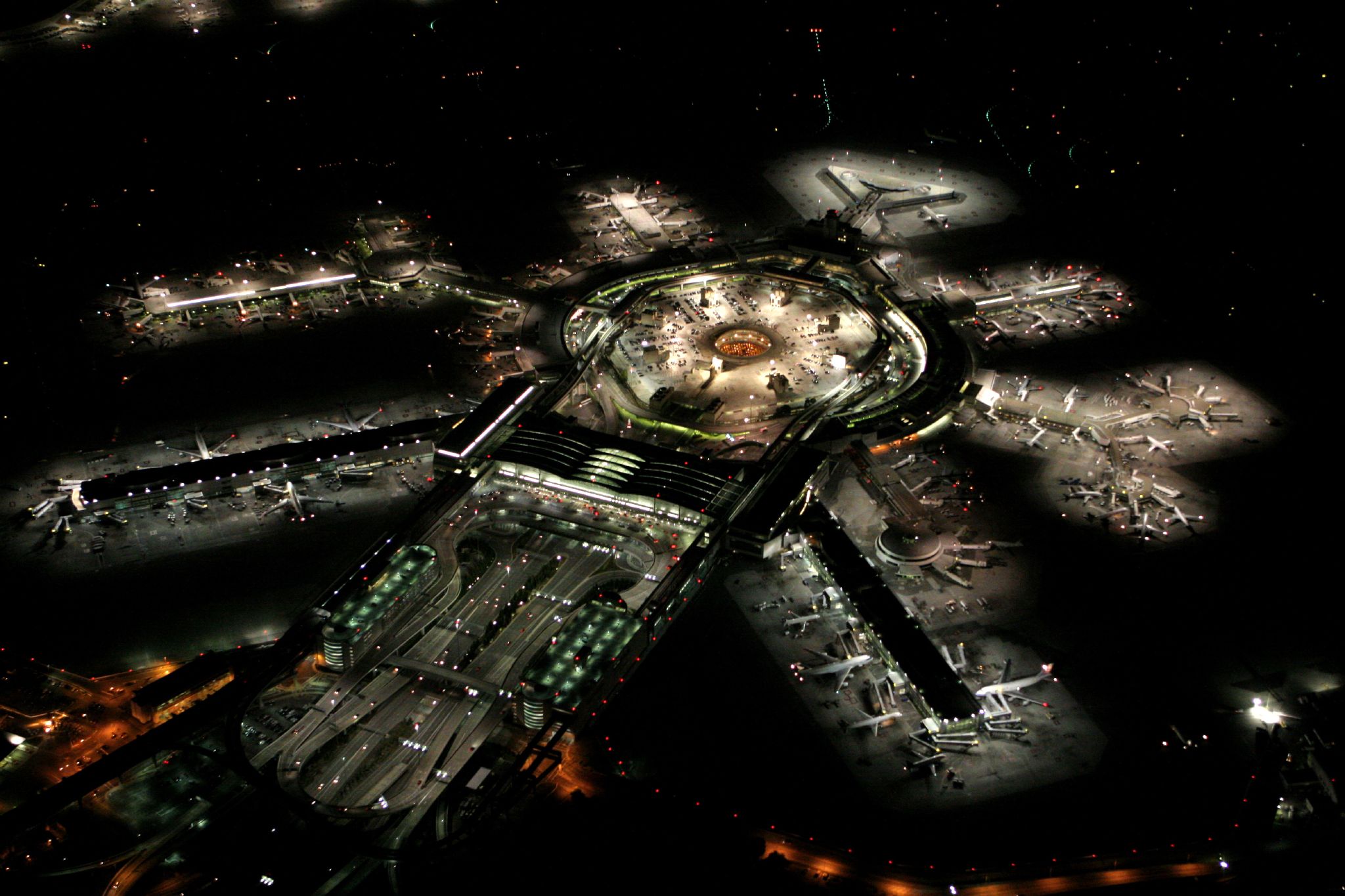







 Get the famous weekly
Get the famous weekly 



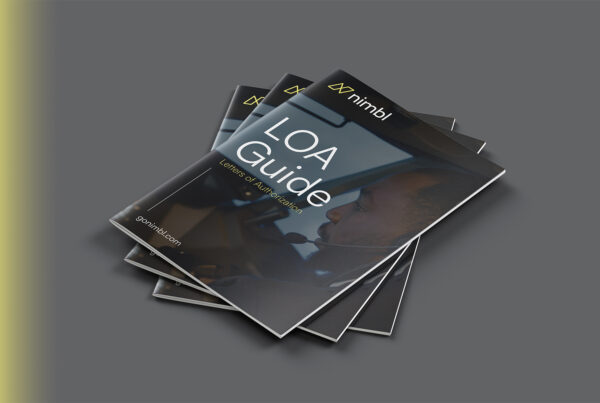
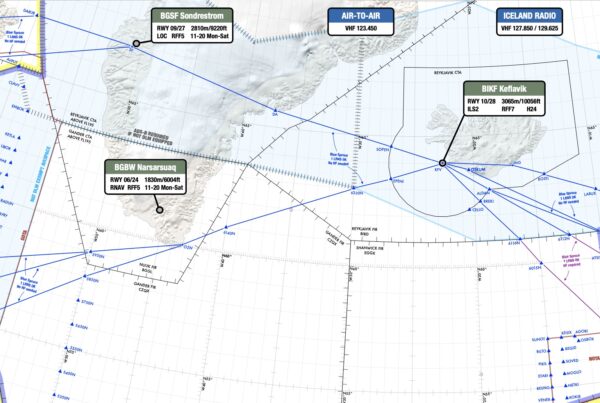
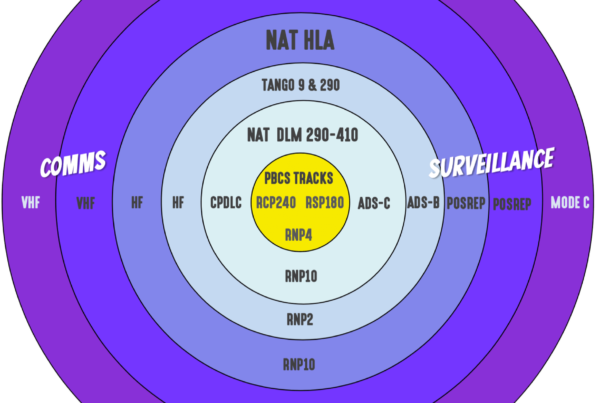
Here’s the problem. ATC employees in the US are notorious jerks. The problem is they don’t have to be accountable to the folks they deal with!
It’s a little like an elementary school teacher spending their entire professional lives justifying themselves in front of 6-year olds. Will they not walk off the job in the afternoon, chest puffed, feeling like they are the smartest guy/gal to ever walk the face of earth?
It’s a little like a nurse – who has no idea about anything, but in a professional setting between a nurse and a patient, will ALWAYS be made to file like she is the smarter one (unless the doc walks in).
The problem with ATC is they deal with professional pilots most of the time. Professional pilots get a paycheck from someone, and that someone will terminate that pilot if they get into fights with ATC.
The result is: No one ever speaks back to to ATC, no matter how moronic, nonsensical, inconsiderate or downright criminally negligent they screw up!
After a long flight from Europe, we arrived to KLAS late at night, after 12 hours on the flight deck they do this silly thing where they give you visual approach into 19R that has you on an offset final and then a visual turn after passing Stratosphere tower – in the middle of the night next to the blinding lights of the strip, that darn airport is the darkest blotch of nothing out there! So of course, we had to go missed. Great.
If more pilots spoke up and slammed an ATC’s false sense of superiority (sitting in a chair sipping coffee is not comparable to hauling 150.000 lbs of metal through the air at 500 knots) – then perhaps these clowns would start to thing. Perhaps they would start to be accountable.
See, I own my own aircraft and I fly part 91 only. I am my boss. If you don’t like what I have to say to ATC, tough luck. I treat everyone fairly. But cross me once, it’s on you.
The problem is not isolated to the US. Once in France, these dimwits changed our entire route clearance without ever notifying us. Throughout the entire flight, they keep clearing direct to waypoints no one had ever heard of. At same point, I just had to stomp my foot down on the French ‘lady’, and I use that term loosely, and I said: ‘Ma’am, we were never ever that amended clearance. I am 5nm direct WAYPOINT and we will proceed as filed after that unless and until you issue clear progressive instructions’. That shut her up good and she cleared us right out of her airspace.
The lesson here is that between the PIC and any ATC monkey, guess who’s in charge – it’s the PIC, and the PIC only. The PIC is the ONLY authority as to the safe conduct of the flight – NOT the ATC rejects. If we all had a little less respect for whoever is staffing the ATC mic that day, and a little more balls to tell them every time they screw up, the skies would be a safer place.
OH AND LASTLY, one of my favorite radiotelephony phrases of all times is when I tell the ATC clown ‘Oh and I have a number for you to call once I land, ready to copy?’ – That gets them good.
Screw them. I hope they will all be replaced by an iPad soon.
Shame on this Controller, disgracefull CRM.
Arrogance is an enemy of Flight safety.
When I was an unexperient Pilot I had my life saved by a Controller, it would probably result in an unhappy ending if I had to deal with this one at that time!
I hadn’t considered national pride or animosity until reading these comments. For a moment, I forgot how sensitive some people can be.
This incident wasn’t about separation, as evidenced in the tone of the controller (if you bother to listen). The controller was annoyed that someone dare ask for more than he was offering and create more work than he was expecting.
Yes, the Lufthansa pilot also let his frustration slip at one point, but they continued to behave as professionals, even after a very long duty day.
I have flown over much of the world and never experienced the same level of ego from ATC as here at home. Yes it’s busy, but that doesn’t give them the right to dump on us anymore than we get to dump on them after a long day. As for national grievances, you need to grow up and behave as the professional you’re being paid to be!
Adding a level of safety should never be criticized or discouraged. The job is to get everyone home safe and preferably on time; if we have to add a few minutes for extra safety, then build it in.
Those “top notch” controllers could have easily made space in the time they had (unless they’re admitting it was beyond their abilities? We are the pioneers, which is awesome, but the rest of the world is more like Apple, or Nintendo or Toyota; they learn from our successes or mistakes and make improvements. Our hub and spoke, giga airport model has reached full capacity; that’s part of why we’re seeing certain problems.
To be fair, we (USA) have some of the finest controllers in the world and some of the best pilots too; that doesn’t give us the right to be unprofessional to others when we can do something they can’t (for whatever reason). We do some real cowboy crap here, that usually works. The rest of the world is not the USA and they’re also doing their best.
At the end of the day, this was nothing more than ego and it needs to be checked at the door.
Fly safe everyone.
My comment is thanks USA ATC for making my life a lot harder when I fly to Germany–they hold a grudge as well as gringo’s.
Second, giant “C” word to the ATC controller that night for being a massive “D” word.
This controller should be immediately be relieved of all duties; physc-eval, and terminated.
Finally, lay off the coffee, get some rest, and think about the 300+ passengers onboard that flight.
I was on that Flight. It was an absolute nightmare, starting with the delay in Munich. Putting all the passengers and crew at risk is beyond me. This turned into a critical situation and it should have never come to that. I was on this aircraft for over 15 hours!
Pilots should have advised ATC much sooner that they needed an approach other than what was being advertised. Arrival spacing and sequencing starts hundreds of miles away. During busy arrival pushes into SFO, there’s not much room to change things up at the last minute.
Imagine you invited someone over for Thanksgiving dinner, and right before you started to carve the turkey they told you that they’re vegan. Well that’s kind of last minute, isn’t it? Either the turkey gets cold while you cook up some tofu, or they have to wait until you’ve finished eating and then you can start cooking them something else. Either way sucks, and could have been avoided if there had been earlier communication about needing something special.
And for anyone who has the time and energy, look up on flightradar24 what the arrivals into SFO looked like during and after the incident. Planes are paired up like Noah’s Arc on final for about the next 45 minutes. There really truly wasn’t room for LH at that time.
ILS special now?
It’s an IFR flight all the way until the visual is accepted.
You already know I am Vegan
I’m picking up a distinct tone of “stupid Americans, they don’t know what they’re doing” which is not helpful. Actually they know exactly what they’re doing, which is getting a lot of planes into an airport with two closely spaced parallel runways. The discussion is openly hostile on the LinkedIn post.
Part of the problem here is a cultural difference, in that while in most of the world ATC seems to defer to pilots, in the US ATC takes the attitude that they are running the show and you are a pawn on their chess board. It’s tedious sometimes but that’s the way it is.
Americans don’t liked to be talked down to by Europeans, especially Germans, which is worth remembering.
When I go to Europe I’m expected to understand I’m a guest and I need to adapt to the way they do things there, even if it’s different than what I planned on or expected.
Nah sorry mate, it is a case of stupid Americans not respecting that others have rules and procedures too. I’ve heard them operating into Frankfurt often, embarrassing.
I agree completely with MM’s comments above, and being based in NorCal, I’ve witness that kind of jackass behavior in the past on the frequency by a select few controllers; totally unacceptable and a disgrace to their profession and coworkers. NorCal has a fantastic group otherwise, but we’re dealing with humans; 100% isn’t always achievable.
There is a gray area of missed opportunity that could be explored. If i recall correctly, if available, turbojet aircraft are expect to follow an electronic glide path for visual approach’s? The nuance of the discussion is really about separation, vs instrument flying. I personally always display a glide path to the runway whether it’s published or I’ve created it with the FMS. In the case of Lufthansa, they’re splitting hairs, policy may prohibit a full on visual, what would prevent accepting the ILS/LPV/GLS guidance to the runway in visual conditions, retaining the electronic guidance, flying by reference to instruments, while providing the opportunity for visual separation from other aircraft?
I think a compromise could be reached that meets policy needs and ATC volume concerns.
Why not brief to accept a visual approach with ILS/GLS/RNP backup? fly final approach as per the plate, and visual authority allows you to choose your speed and intercept heading. A win-win.
It doesn’t mean you fly with no electronic guidance, nor autopilot?
What gives, lufty?
I’m guessing “ze Germans” are hard fast on syntax, and how they define “visual approach”. You and I came to the same conclusions at the same time, they’re splitting hairs, this is a separation vs guidance issue. Time to see the bigger picture and understand how to work in the system.
I’m down in Mexico a lot, and I’m seeing an evolution with the same controllors i work with on frequency at SJD, moving more to visual sequencing in a US style. (The arrival and approach to 34 is a circuitous expedition of about 25 miles if flown by the number). We need to collaborate with each other, pilots and ATC, we all win when the egos go in the dust bin and creativity and accommodation rule.
As a an ATC hound, I admit, the controller’s attitude was an added stressor for the Captain. As a courtesy to the Captain, a can do attitude by the controller would have been a welcome music to the ears of the long haul flight crew. Other suggestions here are relevant, but approach control knows this flight is arriving with that constraint, or should know Lufthansa ‘s policy and made the necessary adjustments to get them sequenced in in a timely manner, graciously.
This controller should be relieved of his/her post! Completely unacceptable behavior and lack of professionalism. Conversation between pilots and controllers are never just over! They are there to ensure our safety and provide separation between aircraft. It most likely would have worked out better with just a Unicom frequency and self spacing. Sad day for us here in the states that we are supposed to have the best ATC system and controllers, we failed miserably in this case and I hope the shift supervisor is also looking at the facility from outside the fence!
Agree.👍
Not mentioned also is Lufthansa having a strict policy to take out pilot discretion and judgement, if the policy even actually exists. Lufthansa is at SFO nightly and SFO operates this charted visual routinely at night. More often than issuing the full ILS approach. Do all of the other Lufthansa flights deny the visual? Or are they not adhering to policy? Or did this pilot make that up because he didn’t want to do a visual? Visual approaches are expeditious and safe. When the visual approaches are not in use at SFO delays are extensive and ground stops get ridiculous. So many airports in the EU require slots because of lack of efficiency and over regulation.
Yes we all like to blame us the controllers for unprofessionalism. However, until you’ve worked a busy final you have zero understanding at what this does. The pilot I’m sure checked in with approach with the current ATIS. Which I have no doubt said expect visual approach for 28R. They should have indicated at that point they needed the ILS and couldn’t accept a visual approach. So while the plane is still 30 miles from the airport the planes could be shuffled around to accommodate this. Turning final is not the time to indicate you can’t accept something that you knew the entire time. Was the controller rude? Possibly. Would I have diverted them? No. But that’s me and none of us know the real scenario or the backstory. As far as the supervisors taking action. Ha you’re funny. Supervisors generally are certified on one easy sector and only get currency when there’s no traffic. They know better than to pull a controller off position…in fact the supervisor is probably the one that told them to hold them. Read up on TBFM and maybe you’ll understand flows in and out of airports.
And also the article is completely wrong about a visual approach. A visual approach is the pilots responsibility to fly the correct descent angle and keep lined up with the runway. Not provide their own separation. My job is still to maintain proper spacing between aircraft. A visual just means that I am not clearing them for a published approach and the pilot must do that on their own. Whether they want to track the localizer, GPS or ILS inbound on their own…or just eyeball it. What the author is referring to is called “traffic to follow”. Yes in that case I am putting it all on the pilots to maintain visual with the preceding traffic as well as the runway. But that was not used in this case. That would be “Lufthansa 858 heavy, traffic to follow is 12 o clock, 4 miles 4000ft Airbus 319”. If they called in sight I would say “maintain visual separation with the Airbus, cleared visual approach 28R.”
47 years flying, never heard, “traffic to follow.” Add, English second language, long flight flight, and SFO stress.
ATC controllers, Am I up here because your down there or are you down there because I am up here? Check the PILOT / controller phraseology guidance. It’s paramount WE are right, not YOU are right.
Xactly. Agreed.